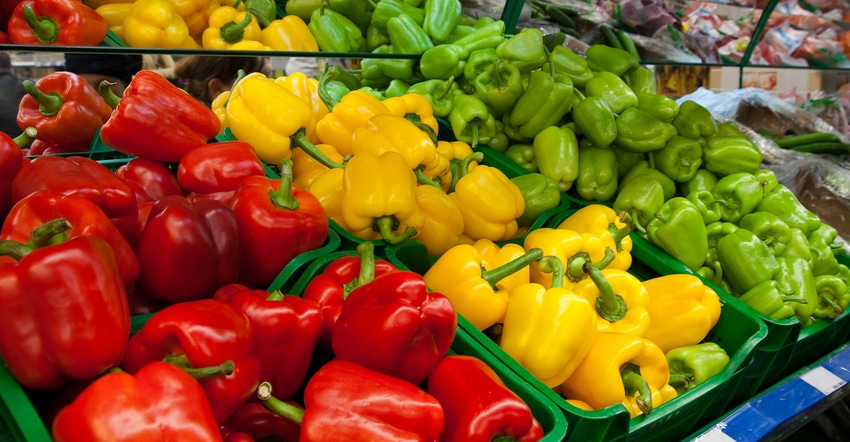December 16, 2021

Improving the safety and water efficiency of specialty fruit and vegetable crops with smart surfaces will be the goal of a new transdisciplinary project led by Texas A&M University. A $2.4 million grant from the National Institute of Food and Agriculture of the U.S. Department of Agriculture. is funding the project.
The four-year project, titled “Next-Generation Smart Surfaces and Coatings to Improve Food Safety and Water Efficiency of U.S. Specialty Crops,” will involve Texas A&M’s Department of Horticultural Sciences and Artie McFerrin Department of Chemical Engineering. The project will focus on the development and design of smart, novel surfaces and coatings for production agriculture.
Luis Cisneros-Zevallos, a professor in the horticulture department of Texas A&M’s College of Agriculture and Life Sciences, Bryan-College Station, will serve as lead investigator for the project. Mustafa Akbulut, an associate professor in the chemical engineering department of Texas A&M University Engineering, will serve as project co-leader.
Why is the project needed?
Foodborne illnesses represent a significant health burden. According to Centers for Disease Control and Prevention survey data, about 10 million Americans per year suffer from domestically acquired foodborne illnesses. And illness caused by contaminated specialty crops is estimated to cost the domestic economy approximately $18 billion.
“Considering the enormity of the burden of foodborne illnesses, even a 1% improvement in overall microbiological safety of specialty crops through the utilization of this technology can translate into a significant reduction in outbreaks and hospitalization as well as economic savings,” Cisneros-Zevallos said.
The researchers are tackling food safety issues by developing novel spraying or dipping solutions and coatings to improve the microbiological safety and hygiene of farming tools and accessories used in harvesting. They will also investigate the use of this technology in conjunction with contact surfaces used for storing, sorting and processing specialty crops.
“This project will lead to the creation of a safer and more affordable food supply and enhance quality of life by reducing the risk of foodborne illness associated with specialty crop food and food products,” Cisneros-Zevallos said.
Akbulut noted the project will also serve to bring a broader awareness of the emerging technologies of sanitary design that can be applied to tools and surfaces used during harvesting and post-harvesting.
Both said the successful completion of the project will contribute toward enhancing the ability of specialty crop growers and packers to produce, pack and market safe commodities for U.S. consumers.
Project objectives
The novel spraying and dipping-based formulations will effectively inhibit bacterial adhesion on select polymer, wood and metal surfaces.
Researchers hope project results will help in the development of scalable processes for the permanent modification of metal and polymer harvest and postharvest tools and equipment with nanotextures during manufacturing.
“Another goal is to significantly reduce the amount of water needed in cleaning and sanitizing harvest and postharvest equipment, tools and containers, as well as food contact surfaces used in packing, sorting and processing facilities through the application of nanotechnology-based smart design,” Cisneros-Zevallos said.
He said informational outreach objectives will involve extensive multistate efforts to disseminate project results to stakeholders on key features and benefits of any technologies developed.
“This will be done with the specific goal of maximizing the widespread use and adaptation of such technologies in specialty crop production, processing and packing,” Cisneros-Zevallos said.
He said the project will also develop relevant guidance on the use of surface coatings in production that complies with U.S. Food and Drug Administration regulations.
“In this project, we will pay particular attention to developing methods that can readily be performed by any person familiar with farming operations and through identifying chemical and physical components that are easily available in the market at reasonable prices,” Akbulut said. “After establishing best practices, we will record video instructions suggested for specific items or objects to be used in the production of specialty crops.”
Project implementation
The team of researchers and experts on the project represent 10 universities and the USDA. In addition to Cisneros-Zevallos and Akbulut, team members from Texas A&M will include Joe Masabni, Texas A&M AgriLife Extension Service vegetable horticulturist, Dallas; Alejandro Castillo, associate professor, Department of Animal Science and Department of Food Science and Technology, Bryan-College Station; and Matthew Taylor, professor, Department of Animal Science.
Team members outside of Texas A&M include Carlos Crisosto, University of California–Davis; Younjin Min, University of California, Riverside; Jorge Fonseca, USDA, Maryland; Angelos Deltsidis, University of Georgia; Keith Schneider, University of Florida; Leslie Bourquin, Michigan State University; Andre Biscaia, Camila Rodrigues, and Adam Rabinowitz, Auburn University; Casey Barickman, Mississippi State University; Ruplal Choudhary, Southern Illinois University; and Otto Simmons, North Carolina State University.
The team will investigate antifouling characteristics on materials of interest through a combination of nanotexturing and the attachment of inert, long-chain hydrophobic molecules. The ease of cleaning of bacteria and dirt will be evaluated through hydrological assays.
Regional and national outreach activities will be developed to disseminate project results through the integration of research and educational outreach.
“We will present results at national professional meetings and organize workshops for specialty crop growers and packers as well as farming tool, accessory and surface manufacturers,” Cisneros-Zevallos said. “The goal will be to develop and identify best management practices for inhibiting pathogen attachment and transmission to consumers.”
Source: is AgriLife TODAY, which is solely responsible for the information provided and is wholly owned by the source. Informa Business Media and all its subsidiaries are not responsible for any of the content contained in this information asset.
About the Author(s)
You May Also Like




